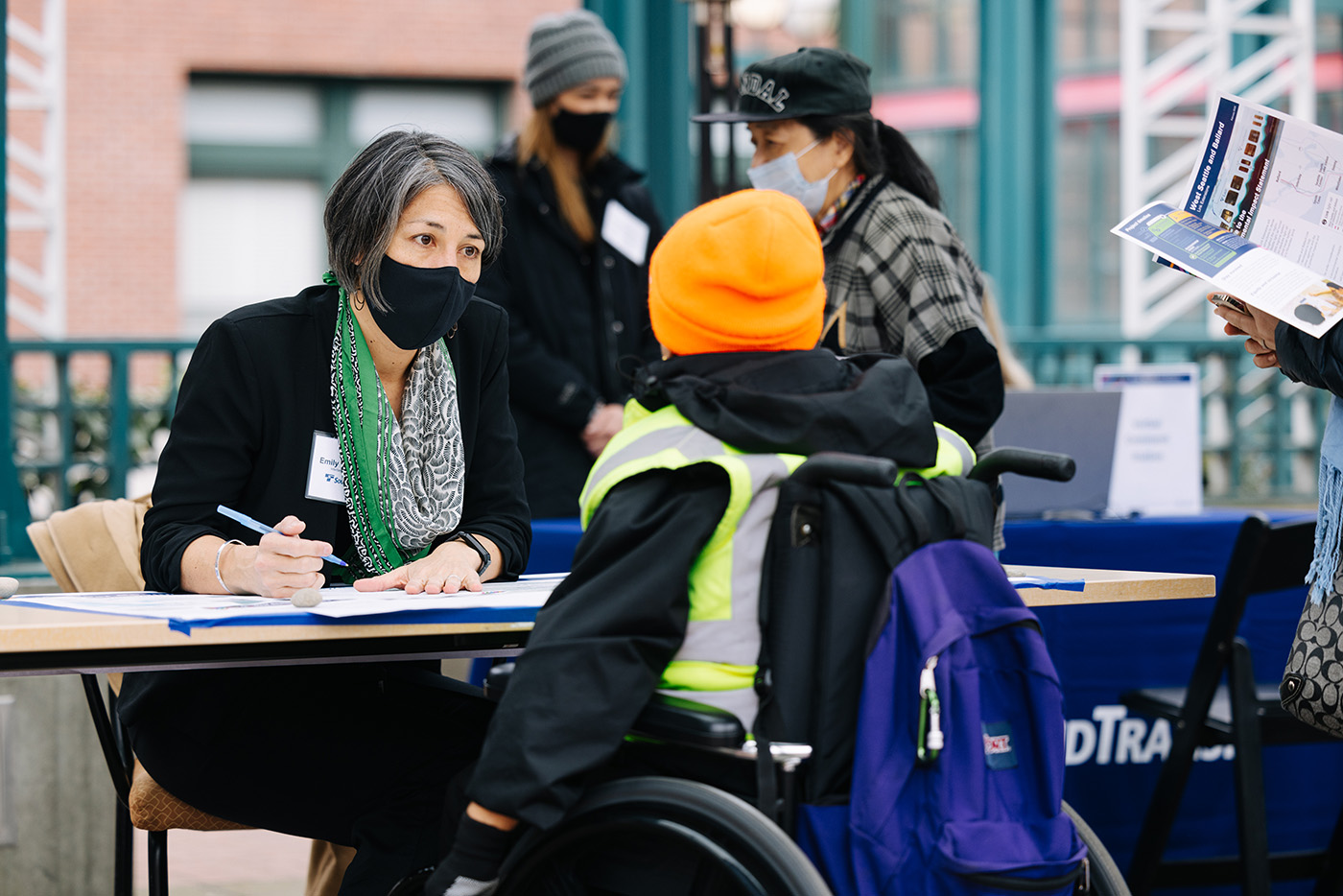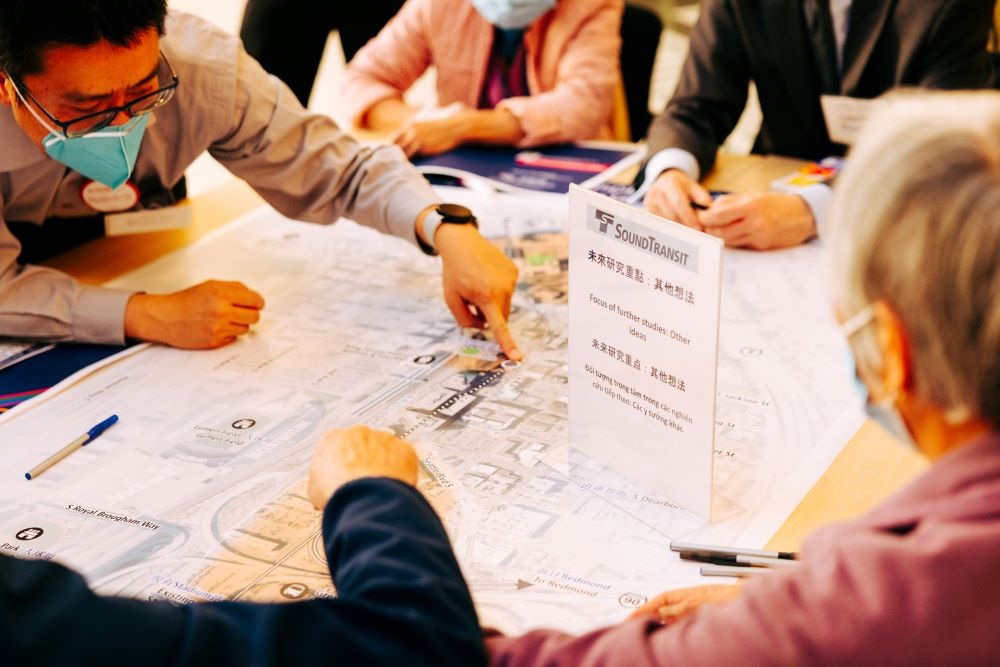2022 WSBLE Draft EIS

Sound Transit evaluated the WSBLE projects in a Draft Environmental Impact Statement (EIS), published on Jan. 28, 2022. After publication, a 90-day public comment period followed. The WSBLE Draft EIS was developed to help Sound Transit, partner agencies, and the public better understand the potential effects of the alternatives on the natural and built environment and transportation system and find potential mitigation measures.
Sound Transit Board’s preferred alternatives
In July 2022, after reviewing the WSBLE Draft EIS and the comments from Tribes, the public and agency partners, the Sound Transit Board identified the preferred alternative for the WSLE and requested further study for the BLE. Read the July 2022 press release and Board Motion for more information.
After further studies from August 2022 to February 2023, the Sound Transit Board identified a preferred alternative for the Ballard Link Extension. Read the March 2023 Board Motion, the press release, and July Board Motion for more information.
Environmental review timelines
The extensions were initially on the same environmental review timeline. However, given additional environmental review needed for project refinements for BLE resulting from the Sound Transit Board action in March 2023, environmental review for the two extensions will now proceed on different timelines.
The WSLE proceeded to a Final EIS, expected to be published in 2024. A new BLE Draft EIS will be published in early 2025, reflecting actions by the Sound Transit Board in March and July 2023. The BLE alternatives will be updated, including an analysis of the preferred alternative and other refinements and alternatives identified in March 2023 and July 2023 Board Motions. The new BLE Draft EIS will build upon and incorporate the analysis in the WSBLE Draft EIS, including all previous scoping comments, public outreach and feedback, and environmental analysis.
Want to take another look at the WSBLE Draft EIS?
You can still explore the Draft EIS. The Executive Summary provides an overview of the Draft EIS. It condenses the larger Draft EIS to help readers quickly become acquainted with the project.
WSBLE Draft EIS Executive Summary
You can view the entire WSBLE Draft EIS document online.
*After the WSBLE Draft EIS was published in January 2022, the Sound Transit Board identified different preferred alternatives than what are shown in the WSBLE Draft EIS. To learn more, visit the West Seattle Link Extension project page and the Ballard Link Extension project page.
States what problems the project will address and why the investment in this transit project is needed.
Describes the alternatives evaluated in the Draft EIS, including alignment and station locations, how they will be constructed, and how long construction will take.
Presents analysis of the existing transportation system in the project area and discusses potential impacts of the alternatives to regional facilities and travel and transit operations. Discusses ridership and travel times for each alternative as well as parking impacts in addition to pedestrian and bicyclist access at each station area.
Discusses the affected environment and environmental consequences of the project.
Describes the project’s effects on a particular resource, combined with past, present and future effects of other projects. The cumulative impact assessment can identify consequences that might not be apparent when the project is considered in isolation.
Evaluates how the West Seattle and Ballard Link Extensions alternatives meet the project’s purpose and need. It also summarizes the benefits and impacts of each alternative.
- K: Present and Future Development
- L: Supporting Information
- M: Summary of Alternatives Development and Initial Assessment Process
- Appendix N1: Transportation Technical Report
- N.1A Transportation Technical Analysis Methodology Report
- N.1B Existing and Future Transit Routes and Levels of Service
- N.1C Transit Service Integration Technical Memorandum
- N.1D Existing and Future Intersection Levels of Service
- N.1E Construction-Related Roadway Modifications
- N.1F Pedestrian Levels of Service
- N.1G Bicycle Master Plan Project List
- N.1H Historical Collisions by Collision Type
- Appendix N2: Visual Technical Report
- Appendix N3: Noise and Vibration Technical Report
- Appendix N3: Noise and Vibration Technical Report Attachments
- N.3A Noise Measurement Data, Site Details, and Photographs
- N.3B Vibration Measurement Site Photographs
- N.3C Vibration Propagation Measurement Results
- N.3D Maps of Noise Impact Assessment
- N.3E Maps of Vibration Impact Assessment
- N.3F Tables of Noise Predictions
- N.3G Tables of Vibration Predictions
- N.3H Vibration Analysis of Category 1 Uses and Special Buildings
- Appendix N4: Ecosystems Technical Report
- Appendix N4: Ecosystems Technical Report Attachments
- Appendix N5: Historic and Archaeological Resources Technical Report
- Appendix N5: Historic and Archaeological Resources Technical Report Attachments
*Appendix I is reserved for the mitigation plan and will be included in the Final EIS.
Equity and inclusion
Sound Transit is committed to centering communities along the project corridor and engaging communities of color and low-income and other vulnerable populations throughout the public involvement process. During the environmental review process, Sound Transit conducted an environmental justice analysis, which is included in the WSBLE Draft EIS. The analysis:
- Describes the demographics of the project corridor.
- Evaluates whether the projects would result in disproportionately high and adverse effects to communities of color and low-income communities.
- Considers potential project benefits such as improved access to opportunity.
- Documents our efforts to involve communities of color and low-income populations in the planning process and what we have heard so far from outreach efforts.
Along with the Draft EIS environmental justice analysis, Sound Transit and the City of Seattle have partnered on the Racial Equity Toolkit (RET) process for the projects. The RET lays out a process and a set of questions to guide the development, implementation and evaluation of the projects to advance racial equity. The RET process began early in project development, informing data analysis, technical evaluation and the focus and extent of community engagement. During the environmental review phase, the RET builds on the environmental justice assessment for the projects, documenting potential project impacts and benefits, and community feedback. However, given that the RET process is guided by a different framework than the EIS environmental justice requirements, the report on the RET process and findings is structured differently, and is oriented around RET outcomes for the projects. Our RET report on the process, requirements, outcomes, findings and community feedback is available for your reference.
Additional studies

Chinatown-International District (CID) Additional Study Results (2023 - 2024)
In March 2023, the Sound Transit Board adopted motion M2023-18 which identified a preferred alternative for the Ballard Link Extension project. As part of this motion, the Board directed staff to further study ways to minimize or eliminate construction impacts to the Chinatown-International District (CID) to significantly reduce the duration and effects of construction and maximize connections to all regional and local transit modes. Materials from these additional studies are included below.
Construction approach and duration- System Expansion Committee 11/14/24 presentation [English] [Traditional Chinese] [Simplified Chinese] [Vietnamese]
- CID Construction Click & Learn Activity [English] [Traditional Chinese] [Simplified Chinese] [Vietnamese]
- Report on construction approach and duration for CID Station alternatives [English] [Traditional Chinese] [Simplified Chinese] [Vietnamese]
- System Expansion Committee 11/14/24 presentation [English] [Traditional Chinese] [Simplified Chinese] Vietnamese]
- CID regional and local access connections video [English] [Cantonese] [Mandarin]
- Maximizing regional and local connections resource packet [English] [Traditional Chinese] [Simplified Chinese] Vietnamese]
Additionally, the Board directed Sound Transit staff to work with the City of Seattle and King County and in partnership with the community to explore opportunities to advance improvement projects and public transit connections through the South Downtown Hub plan. Check out the South Downtown Hub Online Open House to learn more.
CID additional study materials are being provided for informational purposes and as resources for the Sound Transit Board and the public in advance of Ballard Link Extension Draft EIS publication in 2025, which will be followed by a public comment period and potential Board action to confirm or modify the preferred alternative.
South Lake Union Additional Studies (2023 – 2024)
In 2023 and 2024, the Sound Transit Board directed the project team to study additional station locations and alignment concepts in the South Lake Union area. Materials from these further study periods are included below.
SLU Feasibility Study (2024) SLU Further Studies (mid-2023)BLE Further Studies (late 2022 – early 2023)
In July 2022, the Sound Transit Board directed the project team to complete additional further studies. Staff held community workshops, open houses, stakeholder meetings and surveys between September 2022 and January 2023.
For an overview of the further studies results, read the Further Studies Executive Summary and reports or the Further Studies Engagement Summary. Descriptions and key findings are included below by segment.
Chinatown-International District (CID) Downtown Interbay/BallardSLU Feasibility Study (2024)
In December 2023, the Sound Transit Board directed staff to assess the feasibility of a potential new alternative in the South Lake Union (SLU) and Denny area. This light rail alignment concept would locate the SLU Station roughly two blocks west of the current preferred alternative, near 5th Avenue North and Harrison Street, in tandem with a Denny Station Shifted West, outside of the Westlake Avenue right of way.
Between December 2023 and May 2024, Sound Transit engaged the public in various forums to share information and gather feedback about the SLU Feasibility Study and its findings. These engagement activities included an online survey, two live webinars, and over 40 stakeholder and community briefings.
At the May 23 Sound Transit Board of Directors meeting, Board members discussed and reviewed SLU Feasibility Study findings and community feedback about a potential new alternative in the SLU and Denny area. Board members also considered the staff opinion recommending that the Board take No Action, keep the current preferred alternative, and not carry forward the potential new alternative.
After discussion, the Board took No Action, keeping the existing alternatives and the current timeline for the BLE Draft Environmental Impact Statement, expected in early 2025. This meant that the BLE preferred alternative remained Denny Station Shifted North and an SLU Station at 7th Avenue North & Harrison Street.
In arriving at this outcome, Board members weighed community priorities, regional needs, input from stakeholders and agency partners, and community feedback. Thousands of community members engaged with us during the feasibility study process. Thank you for your input. You can access a summary of recent engagement activities related to this work and community feedback themes online.
For more information:
SLU Further Studies (mid-2023)
Starting in March 2023, following direction from the Board, staff convened technical work sessions and associated engagement activities to clarify the technical, financial, schedule and risk implications of the Denny route and station locations and share findings with the community. Technical work focused on a range of topics including utility relocations, constructability, construction schedule, roadway closures, and cost. New station and alignment concepts explored in these studies and engagement included:
- A Denny Station shifted north
- A Denny Station shifted west (consolidated station concept with the Harrison St Station)
Sound Transit hosted numerous community briefings and two public webinars to gather feedback from transit users and inform the July 27 Board status report and action.
For more information:
